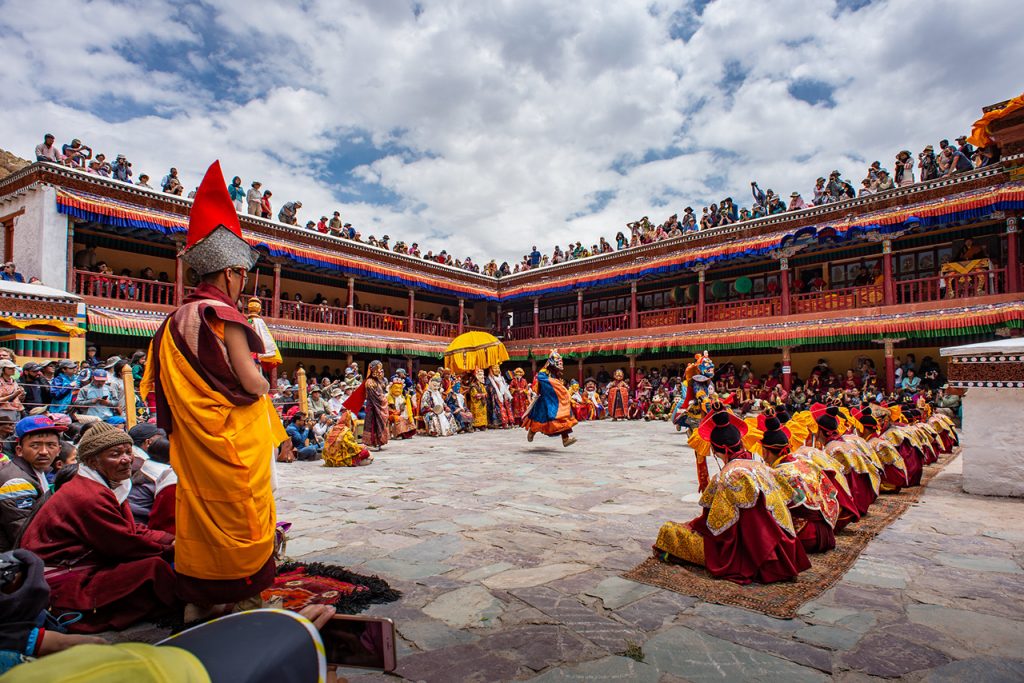Ladakh, the place is located at a height of 9,800 feet and is surrounded beautifully by the Himalayan mountain ranges is famously known as “THE LAND OF HIGH PASSES”. The Ladakh region comprises of some of the highest mountain passes in the world. Ladakh is the only cold desert of India and is surrounded by jagged mountain passes, plateaus and barren cliffs. Due to this, it offers various adventurous opportunities in water rafting, trekking and mountaineering. The Tibetan culture of the east is conglomerated with the Buddhist religion which adds an eccentric outlook to the region of Ladakh. Reflecting the rich Tibetan culture, the monasteries in Ladakh represent the true scintillating vibes of the Buddhist religion. Mostly located at the apex of the mountains, these monasteries offer an endearing picturesque view which showcases the peace and harmony of nature. Each monastery celebrates its own festival which reflects the unique culture prevalent in each of them. Ladakh has too much to offer…..particularly to the tourists…. right from the beautiful landscape to the refreshing rivers. Let’s take a look at some of the amazing and enriching monasteries of Ladakh.
1. Diskit Monastery

Diskit Monastery is located in Nubra Valley, which is a beautiful place surrounded by the Shylok river. The beauty of the valley can be viewed from atop the monastery. The Diskit Monastery consists of a 106 foot tall Maitreya Buddha at its entrance which is a representation of pure dharma and complete enlightenment of the Buddhist religion. It was founded by Changzem Tsera Zangpo in the 14th century and it belongs to the Gelugpa sect of Tibetan Buddhism.
2. Hemis Monastery

The Hemis Monastery constitutes a famous museum which showcases a collection of various ancient artifacts, Buddhist relics and statues. Artistic paintings and pictures cover the walls of the verandahs beautifully. It is home to the statue of Guru Rimpoche who is believed to be the founder of the Hemis Monastery. Besides this, there are two Buddha statues which overall compliment the architectural features of the monastery.
3. Thiksey Monastery

Situated at an altitude of 11800 feet, the monastery is cared for by the people of the Yellow Hat Sect. The 49-feet tall statue of Maitreya Buddha is a famous attraction of the Thiksey Monastery. It is a twelve-storied monument which consists of ten beautiful temples. Thiksey Gustor festival is celebrated annually every tenth month according to the Tibetan calendar. There is a separate temple singularly dedicated to Goddess Tara. The prayer hall of the monastery consists of a 40-foot tall Lord Buddha statue seated on a lotus which represents cosmic renewal. The famous temples of Thiksey monastery are Lamokhang Temple and Tara Temple.
4. Alchi Monastery

The ancient 11th and 12th century Indo-Himalayan styled wall paintings are the main attraction of the Alchi Monastery. Situated at an altitude of 10200 feet, this monastery was constructed between 958 and 1055 AD by Guru Rinchen Zangpo. The Gompa consists of images of Buddha statues made in clay and the walls are magnificently decorated with bright colours. It also has a dining hall known as “DUKHANG” which is exquisitely decorated in kashmiri architecture. Mahakal and the wheel of life are famous locations present inside the Dukhang. The monastery also consists of a three-story temple named SUMTSEG which is situated in the centre of it. The life of Lord Buddha along with images of his family and followers is beautifully defined in the form of paintings at Sumtseg.
5. Shey Monastery

Shey Monastery is located in the Shey city of Ladakh which is also the summer capital of the city. The monastery is divided into sections comprising of two floors. The ground floor is surrounded with amazing mural paintings while the first floor has various Buddha murals depicted holding different hand gestures and forms. The upper floor, on the other hand has a large library which houses the ancient manuscripts. The assembly hall has the Shakyamuni Buddha statue , while the walls of the hall are designed by the mesmerizing paintings of different sages. A small shrine is present near the Shey Monastery which has a Buddha statue. Butter lamps are used to enlighten the upper floor of the monastery which generally remains dark from the inside.
6. Spituk Monastery

Also known as “Pethup Gompa”; the Spituk Monastery is a blend of both Buddhism and the Hindu culture. It has a large statue of goddess Kali. Spituk Monastery belongs to the era of the 15th century and the assembly hall comprises the largest portion of the monastery. The antique arms, thangka, miniature chortens, ancient masks and sculptures are displayed in the assembly hall. The courtyard of the monastery is painted with beautiful tibetan paintings, while the meditation hall remains open for those willing to perform prayers and meditation.
7. Likir Monastery

The sceneric view of the monastery is visible right from the foothill of the ranges. The Likir Monastery consists of two assembly halls wherein the new hall is about 200 years old. The courtyard consists of a large Juniper tree, while the collection room shows tibetan styled-ancient pots, thangka collections and manuscripts written in the Pali language. The paintings and a wheel of life is present in the verandah of the courtyard. The glass room present exactly opposite to the Gonkhang house remains open for the celebration of the dance festival held there.
8. Lamayuru Monastery

Also famously known as YURU MONASTERY, it is located near Lamayuru village and is known for its mask dance festival which takes place annually. The Lamayuru Monastery consists of prayer wheels, wall paintings and artifacts which shows the ancient culture of Buddhism and how it has evolved over the passage of time. A small portion of the ancient building still stands today while the remaining portion shows the ruined corners of the monastery. It consists of a beautiful prayer hall which remains open for the tourists to enjoy the rich culture of the monastery.





